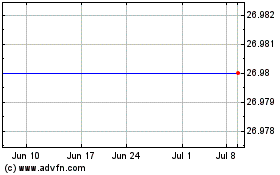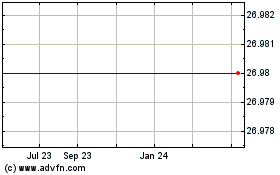Myovant Sciences (NYSE: MYOV), a healthcare company focused on
developing innovative treatments for women's health and prostate
cancer, today announced that the Phase 3 HERO study of once-daily,
oral relugolix (120 mg) met its primary efficacy endpoint and all
six key secondary endpoints in men with advanced prostate cancer.
These results support a New Drug Application (NDA) submission to
the U.S. Food and Drug Administration (FDA) in the second quarter
of 2020 and future regulatory submissions in Europe and Japan.
“An oral gonadotropin-releasing hormone, or GnRH, antagonist for
advanced prostate cancer has been an aspiration for many years,”
said Neal Shore, M.D., Medical Director of the Carolina Urologic
Research Center and HERO Program Steering Committee Member. “If
approved, relugolix would become the first-of-its-kind oral option
for men with advanced prostate cancer.”
In the primary endpoint responder analysis, 96.7% (95% CI:
94.9%, 97.9%) of men receiving once-daily, oral relugolix achieved
sustained testosterone suppression to castrate levels. A responder
was defined as achieving and maintaining testosterone suppression
to less than or equal to 50 ng/dL from Week 5 through Week 48. For
the study to be successful, the lower bound of the 95% confidence
interval of the response rate had to be at least 90%.
Five key secondary endpoints demonstrated superiority to
leuprolide acetate, including rapid suppression of testosterone at
Day 4 and Day 15, profound suppression of testosterone at Day 15,
rapid suppression of prostate-specific antigen (PSA) at Day 15, and
suppression of follicle-stimulating hormone (FSH) at Week 24 (all
p-values < 0.0001). In addition, relugolix demonstrated
non-inferiority to leuprolide acetate on sustained testosterone
suppression through 48 weeks (96.7% vs. 88.8%, respectively) with a
between-group difference of 7.9% (95% CI: 4.1%,11.8%), the primary
endpoint required for regulatory submissions outside of the U.S. In
addition, the pharmacodynamic results showed no testosterone flare
after initiation of relugolix and mean testosterone levels returned
to normal levels within 90 days after treatment
discontinuation.
“With the exciting results from the HERO study demonstrating the
potential of relugolix to provide unique benefits compared to
leuprolide, we look forward to submitting an NDA to the FDA,” said
Lynn Seely, M.D., President and CEO of Myovant Sciences. “We are
now closer to our goal of bringing a precision oral medicine to the
broad spectrum of men with advanced prostate cancer.”
The overall incidence of adverse events in the relugolix and
leuprolide acetate groups was comparable (92.9% vs. 93.5%,
respectively). In the relugolix group, 3.5% of men discontinued the
study early due to adverse events compared with 2.6% of men in the
leuprolide acetate group. The most frequently reported adverse
events, reported in at least 10% of men in the relugolix group,
were hot flashes, fatigue, constipation, diarrhea, and arthralgia.
Unadjudicated major adverse cardiovascular events were reported in
2.9% of men in the relugolix group versus 6.2% of men in the
leuprolide acetate group. These events included non-fatal
myocardial infarction, non-fatal stroke, and all-cause
mortality.
Conference Call Myovant will hold a
conference call today, November 19, 2019 beginning
at 8:30 a.m. EST / 5:30 a.m. PST. The dial-in
numbers are 1-800-532-3746 for domestic callers and +1-470-495-9166
for international callers. A live webcast of the conference call
will also be available on the investor relations page of Myovant’s
website at investors.myovant.com and will remain archived on
Myovant’s website for at least 30 days.
About the Phase 3 HERO Program This randomized,
open-label, parallel-group, multinational clinical study was
designed to evaluate the safety and efficacy of relugolix in men
with androgen-sensitive advanced prostate cancer who required at
least one year of continuous androgen deprivation therapy. Patients
enrolled in the study were randomized 2:1 to receive a single
loading dose of relugolix 360 mg followed by relugolix 120 mg once
daily, or to treatment with leuprolide acetate 3-month depot
injection, respectively.
The primary efficacy endpoint of the study to support U.S.
approval was the ability of relugolix to achieve and maintain
testosterone suppression to castrate levels (< 50 ng/dL) through
48 weeks.
Approximately 1,100 patients are planned to be enrolled in this
study, including approximately 430 patients with metastatic
prostate cancer to support the analysis of a secondary endpoint of
castration resistance-free survival, data which are expected in the
third quarter of 2020, and 138 Chinese patients (enrolled in China
and Taiwan) to support registration in China.
About Prostate Cancer Prostate cancer is the
second most prevalent form of cancer in men and the second leading
cause of death due to cancer in men in the U.S.
Approximately three million men in the U.S. are currently
living with prostate cancer, and approximately 170,000 men are
estimated to be newly diagnosed in 2019. Advanced prostate cancer
is prostate cancer that has spread or come back after treatment and
may include men with biochemical recurrence (rising PSA in the
absence of metastatic disease on imaging), locally advanced
disease, or metastatic disease. Treatment for advanced prostate
cancer typically involves androgen deprivation therapy, which
reduces testosterone to very low levels, commonly referred to as
castrate levels. GnRH agonists, such as leuprolide acetate, or
slow-release injections are the current standard of care for
medical castration. However, GnRH agonists may be associated with
mechanism-of-action limitations, including the potentially
detrimental initial rise in testosterone levels that can exacerbate
clinical symptoms, which is known as clinical or hormonal flare,
and delayed testosterone recovery if the drug is discontinued.
About Relugolix Relugolix is a once-daily, oral
gonadotropin-releasing hormone (GnRH) receptor antagonist that
reduces testicular testosterone production, the hormone primarily
responsible for stimulating prostate cancer, and ovarian estradiol
production, a hormone known to stimulate the growth of uterine
fibroids and endometriosis. Myovant is developing a relugolix
monotherapy tablet (120 mg) for men with advanced prostate cancer
and relugolix combination tablet (relugolix 40 mg plus estradiol
1.0 mg and norethindrone acetate 0.5 mg) for women with heavy
menstrual bleeding associated with uterine fibroids and for women
with endometriosis-associated pain.
Earlier this year, Myovant announced positive top-line data from
two Phase 3 studies, LIBERTY 1 and LIBERTY 2, evaluating relugolix
combination therapy for uterine fibroids, as well as positive
results from a separate bioequivalence study supporting a potential
one tablet, once-daily dosing regimen. Myovant expects to submit an
NDA to the FDA for uterine fibroids in April 2020. Myovant also
expects to announce top-line results from two Phase 3 studies,
SPIRIT 2 and SPIRIT 1, evaluating relugolix combination therapy for
endometriosis-associated pain in the first and second quarters of
2020, respectively.
About Myovant Sciences Myovant
Sciences aspires to be the leading healthcare company focused
on innovative treatments for women’s health and prostate cancer.
The company’s lead product candidate is relugolix, a once-daily,
oral GnRH receptor antagonist. The company has three
late-stage clinical programs for relugolix in uterine fibroids,
endometriosis, and prostate cancer. The company is also developing
MVT-602, an oligopeptide kisspeptin-1 receptor agonist, that has
completed a Phase 2a study for the treatment of female infertility
as part of assisted reproduction. Takeda Pharmaceuticals
International AG, a subsidiary of Takeda Pharmaceutical Company
Limited, granted the company an exclusive, worldwide
license to develop and commercialize relugolix (excluding Japan and
certain other Asian countries) and an exclusive license to develop
and commercialize MVT-602 in all countries worldwide. For more
information, please visit the company’s website
at www.myovant.com. Follow @Myovant on Twitter and
LinkedIn.
Forward-Looking Statements This press-release
contains forward-looking statements within the meaning of the
Private Securities Litigation Reform Act of 1995. Forward-looking
statements include all statements regarding Myovant Sciences’
intent, belief, or expectations regarding future events or results
and can be identified by words such as “anticipate,” “aspire,”
“believe,” “can,” “continue,” “could,” “estimate,” “expect,”
“intend,” “likely,” “may,” “might,” “objective,” “ongoing,” “plan,”
“potential,” “predict,” “project,” “should,” “to be,” “will,”
“would,” or the negative or plural of these words or other similar
expressions or variations, although not all forward-looking
statements contain these identifying words. In this press release,
forward-looking statements include, but are not limited to,
statements and quotes regarding Myovant Sciences’ aspirations to
become the leading healthcare company focused on innovative
treatments for women’s health and prostate cancer, the
Company’s plans and timing to file for approval of once-daily, oral
relugolix for the treatment of men with advanced prostate cancer in
the United States, Europe and Japan, the likelihood of any
approvals, the timing of data readout regarding the analysis of the
secondary endpoint of castration resistance-free survival expected
in the third quarter of 2020, the commercial potential for
once-daily, oral relugolix for the treatment of men with advanced
prostate cancer, and the timing of Myovant’s plans to submit a New
Drug Application to the FDA for uterine fibroids in April 2020 and
to announce top-line results from the SPIRIT 2 and SPIRIT 1 studies
in the first and second quarters of 2020, respectively. Myovant
Sciences’ forward-looking statements are based on management’s
current expectations and beliefs and are subject to a number of
risks, uncertainties, assumptions and other factors known and
unknown that could cause actual results and the timing of certain
events to differ materially from future results expressed or
implied by the forward-looking statements. Myovant
Sciences cannot assure you that the events and circumstances
reflected in the forward-looking statements will be achieved or
occur and actual results could differ materially from those
expressed or implied by these forward-looking statements. Factors
that could materially affect Myovant Sciences’ operations and
future prospects or which could cause actual results to differ
materially from expectations include, but are not limited to the
risks and uncertainties listed in Myovant Sciences’ filings with
the United States Securities and Exchange
Commission (SEC), including under the heading “Risk Factors”
in Myovant Sciences’ Quarterly Report on Form 10-Q filed on
November 12, 2019, as such risk factors may be amended,
supplemented or superseded from time to time. These risks are not
exhaustive. New risk factors emerge from time to time and it is not
possible for Myovant Sciences’ management to predict all risk
factors, nor can Myovant Sciences assess the impact of
all factors on its business or the extent to which any factor, or
combination of factors, may cause actual results to differ
materially from those contained in any forward-looking statements.
You should not place undue reliance on the forward-looking
statements in this press release, which speak only as of the date
hereof, and, except as required by law, Myovant
Sciences undertakes no obligation to update these
forward-looking statements to reflect events or circumstances after
the date of such statements.
Investor Contact: Frank Karbe Chief Financial
Officer Myovant Sciences, Inc. investors@myovant.com
Media Contact:Albert Liao Director,
Corporate CommunicationsMyovant Sciences, Inc.
media@myovant.com
Myovant Sciences (NYSE:MYOV)
Historical Stock Chart
From Mar 2024 to Apr 2024

Myovant Sciences (NYSE:MYOV)
Historical Stock Chart
From Apr 2023 to Apr 2024
